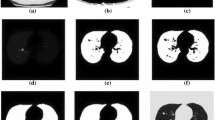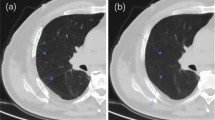Abstract
Lobectomy is an effective and well-established therapy for localized lung cancer. This study aimed to assess the lung and lobe change after lobectomy and predict the postoperative lung volume. The study included 135 lung cancer patients from two hospitals who underwent lobectomy (32, right upper lobectomy (RUL); 31, right middle lobectomy (RML); 24, right lower lobectomy (RLL); 26, left upper lobectomy (LUL); 22, left lower lobectomy (LLL)). We initially employ a convolutional neural network model (nnU-Net) for automatically segmenting pulmonary lobes. Subsequently, we assess the volume, effective lung volume (ELV), and attenuation distribution for each lobe as well as the entire lung, before and after lobectomy. Ultimately, we formulate a machine learning model, incorporating linear regression (LR) and multi-layer perceptron (MLP) methods, to predict the postoperative lung volume. Due to the physiological compensation, the decreased TLV is about 10.73%, 8.12%, 13.46%, 11.47%, and 12.03% for the RUL, RML, RLL, LUL, and LLL, respectively. The attenuation distribution in each lobe changed little for all types of lobectomy. LR and MLP models achieved a mean absolute percentage error of 9.8% and 14.2%, respectively. Radiological findings and a predictive model of postoperative lung volume might help plan the lobectomy and improve the prognosis.
Graphical abstract












Similar content being viewed by others
Data availability
The datasets used and/or analysed during the current study are available from the corresponding author on reasonable request.
Abbreviations
- CT:
-
Computed tomography
- ELV:
-
Effective lung volume
- FEV1:
-
Forced expiratory volume in one second
- FVC:
-
Forced vital capacity
- HAV:
-
High attenuation volume
- LAV:
-
Low attenuation volume
- LLL:
-
Left lower lobectomy
- LUL:
-
Left upper lobectomy
- MAV:
-
Middle attenuation volume
- PFT:
-
Pulmonary function test
- RLL:
-
Right lower lobectomy
- RML:
-
Right middle lobectomy
- RUL:
-
Right upper lobectomy
- TLV:
-
Total volume change
- VATS:
-
Video-assisted thoracoscopic surgery
References
Chang R, Qi S, Yue Y, Zhang X, Song J, and Qian W (2021) "Predictive radiomic models for the chemotherapy response in non-small-cell lung cancer based on computerized-tomography images," Frontiers in Oncology, p. 2548
Bade BC, Cruz CSD (2020) Lung cancer 2020: epidemiology, etiology, and prevention. Clinics Chest Med 41(1):1–24
Ferlay J et al. (2018) Global cancer Observatory: cancer today. Lyon, France: international agency for research on cancer ed
Sihoe AD (2020) Video-assisted thoracoscopic surgery as the gold standard for lung cancer surgery. Respirology 25:49–60
Gu Q et al (2019) Structural and functional alterations of the tracheobronchial tree after left upper pulmonary lobectomy for lung cancer. Biomed Eng Online 18(1):1–18
Tane S et al (2019) Evaluation of the residual lung function after thoracoscopic segmentectomy compared with lobectomy. Annals Thoracic Surg 108(5):1543–1550
Shikuma K et al (2018) Radiologic and functional analysis of compensatory lung growth after living-donor lobectomy. Annals Thoracic Surg 105(3):909–914
Sengul AT, Sahin B, Celenk C, Basoglu A (2013) Postoperative lung volume change depending on the resected lobe. Thoracic Cardiovasc Surg 61(02):131–137
Mizobuchi T et al (2013) Radiologic evaluation for volume and weight of remnant lung in living lung donors. J Thoracic Cardiovasc Surg 146(5):1253–1258
Chen F et al (2015) Postoperative pulmonary function and complications in living-donor lobectomy. J Heart Lung Transplant 34(8):1089–1094
Yamagishi H, Chen-Yoshikawa TF, Oguma T, Hirai T, Date H (2021) Morphological and functional reserves of the right middle lobe: Radiological analysis of changes after right lower lobectomy in healthy individuals. J Thoracic Cardiovasc Surg 162(5):1417–1423.e2
Ohno Y et al (2007) Postoperative lung function in lung cancer patients: comparative analysis of predictive capability of MRI, CT, and SPECT. Am J Roentgenol 189(2):400–408
Ueda K et al (2011) Compensation of pulmonary function after upper lobectomy versus lower lobectomy. J Thoracic Cardiovasc Surg 142(4):762–767
Pang H et al. (2022) A fully automatic segmentation pipeline of pulmonary lobes before and after lobectomy from computed tomography images. Comput Biol Med, p. 105792
Boubnovski M, Chen M, Linton-Reid K, Posma J, Copley S, Aboagye E (2022) Development of a multi-task learning V-Net for pulmonary lobar segmentation on CT and application to diseased lungs. Clin Radiol 77(8):e620–e627
Imran A-A-Z, Hatamizadeh A, Ananth SP, Ding X, Tajbakhsh N, Terzopoulos D (2020) Fast and automatic segmentation of pulmonary lobes from chest CT using a progressive dense V-network. Comput Methods Biomech Biomed Eng: Imaging Visual 8(5):509–518
Wakamatsu I, Matsuguma H, Nakahara R, Chida M (2020) Factors associated with compensatory lung growth after pulmonary lobectomy for lung malignancy: an analysis of lung weight and lung volume changes based on computed tomography findings. Surg Today 50:144–152
Yushkevich PA, Gao Y, and Gerig G (2016) ITK-SNAP: An interactive tool for semi-automatic segmentation of multi-modality biomedical images," in 2016 38th annual international conference of the IEEE engineering in medicine and biology society (EMBC): IEEE, pp. 3342-3345
Isensee F, Jaeger PF, Kohl SA, Petersen J, Maier-Hein KH (2021) nnU-Net: a self-configuring method for deep learning-based biomedical image segmentation. Nat Methods 18(2):203–211
Yabuuchi H et al (2016) Prediction of post-operative pulmonary function after lobectomy for primary lung cancer: a comparison among counting method, effective lobar volume, and lobar collapsibility using inspiratory/expiratory CT. Eur J Radiol 85(11):1956–1962
Shin KE, Chung MJ, Jung MP, Choe BK, Lee KS (2011) Quantitative computed tomographic indexes in diffuse interstitial lung disease: correlation with physiologic tests and computed tomography visual scores. J Comput Assist Tomography 35(2):266–271
Ravikumar P, Yilmaz C, Dane DM, Bellotto DJ, Estrera AS, Hsia CC (2014) Defining a stimuli-response relationship in compensatory lung growth following major resection. J Appl Physiol 116(7):816–824
Shima H et al (2023) Subtyping emphysematous COPD by respiratory volume change distributions on CT. Thorax 78(4):344–353
Dack E et al. (2023) Artificial Intelligence and Interstitial Lung Disease: Diagnosis and Prognosis, Investigative radiology, p. 10.1097
Si-Mohamed SA et al (2022) Automatic quantitative computed tomography measurement of longitudinal lung volume loss in interstitial lung diseases. Eur Radiol 32(6):4292–4303
Yokoba M, Ichikawa T, Harada S, Naito M, Sato Y, Katagiri M (2018) Postoperative pulmonary function changes according to the resected lobe: a 1-year follow-up study of lobectomized patients. J Thoracic Disease 10(12):6891
Funding
This work was partly supported by the National Natural Science Foundation of China under Grant (Nos. 82072008, 62271131), the Liaoning Natural Science Foundation (2021-YGJC-21, 2020-BS-049), and the Fundamental Research Funds for the Central Universities (N2119010, N2224001-10).
Author information
Authors and Affiliations
Contributions
YW, HP, and JS contributed equally to the data collection, processing and analysis, and writing – original draft preparation. JF contributed to the software and investigation. YY contributed to the data curation and validation. SQ, WQ, and JW contributed to the conceptualization, supervision, writing – reviewing and editing, funding acquisition. All authors read and approved the final manuscript.
Corresponding authors
Ethics declarations
Ethics approval and consent to participate
The study was approved by the Medical Ethics Committee of the Affiliated Zhongshan Hospital of Dalian University and Shengjing Hospital of China Medical University. All procedures involving human participants were performed according to the ethical standards of the institutional and/or national research committee and with the 1964 Helsinki declaration and its later amendments or comparable ethical standards. Formal consent was not required for this retrospective study.
Consent for publication
Not applicable.
Competing interests
The authors declare that they have no competing interests.
Additional information
Publisher’s note
Springer Nature remains neutral with regard to jurisdictional claims in published maps and institutional affiliations.
Rights and permissions
Springer Nature or its licensor (e.g. a society or other partner) holds exclusive rights to this article under a publishing agreement with the author(s) or other rightsholder(s); author self-archiving of the accepted manuscript version of this article is solely governed by the terms of such publishing agreement and applicable law.
About this article
Cite this article
Wu, Y., Pang, H., Shen, J. et al. Depicting and predicting changes of lung after lobectomy for cancer by using CT images. Med Biol Eng Comput 61, 3049–3066 (2023). https://doi.org/10.1007/s11517-023-02907-x
Received:
Accepted:
Published:
Issue Date:
DOI: https://doi.org/10.1007/s11517-023-02907-x




